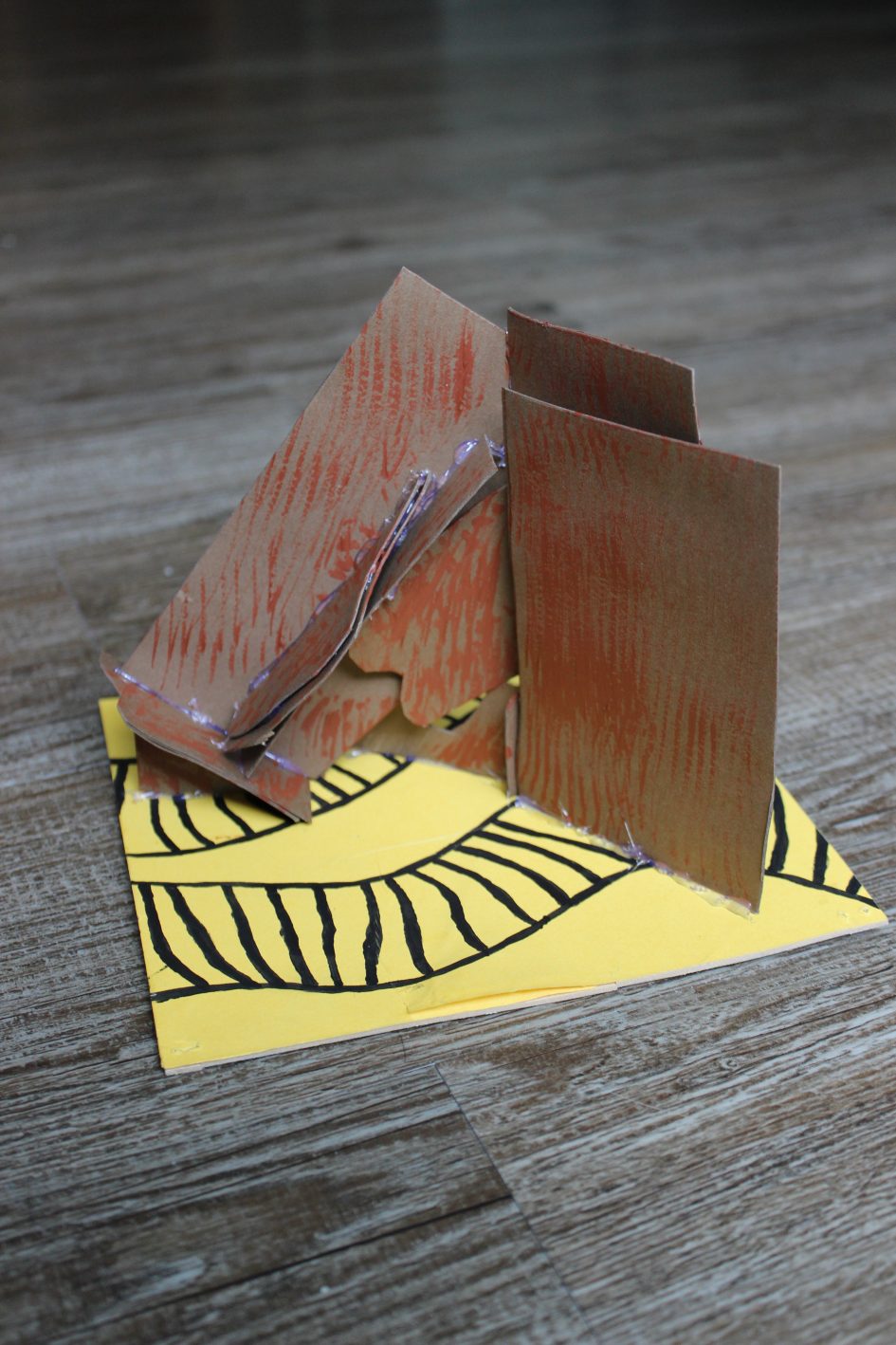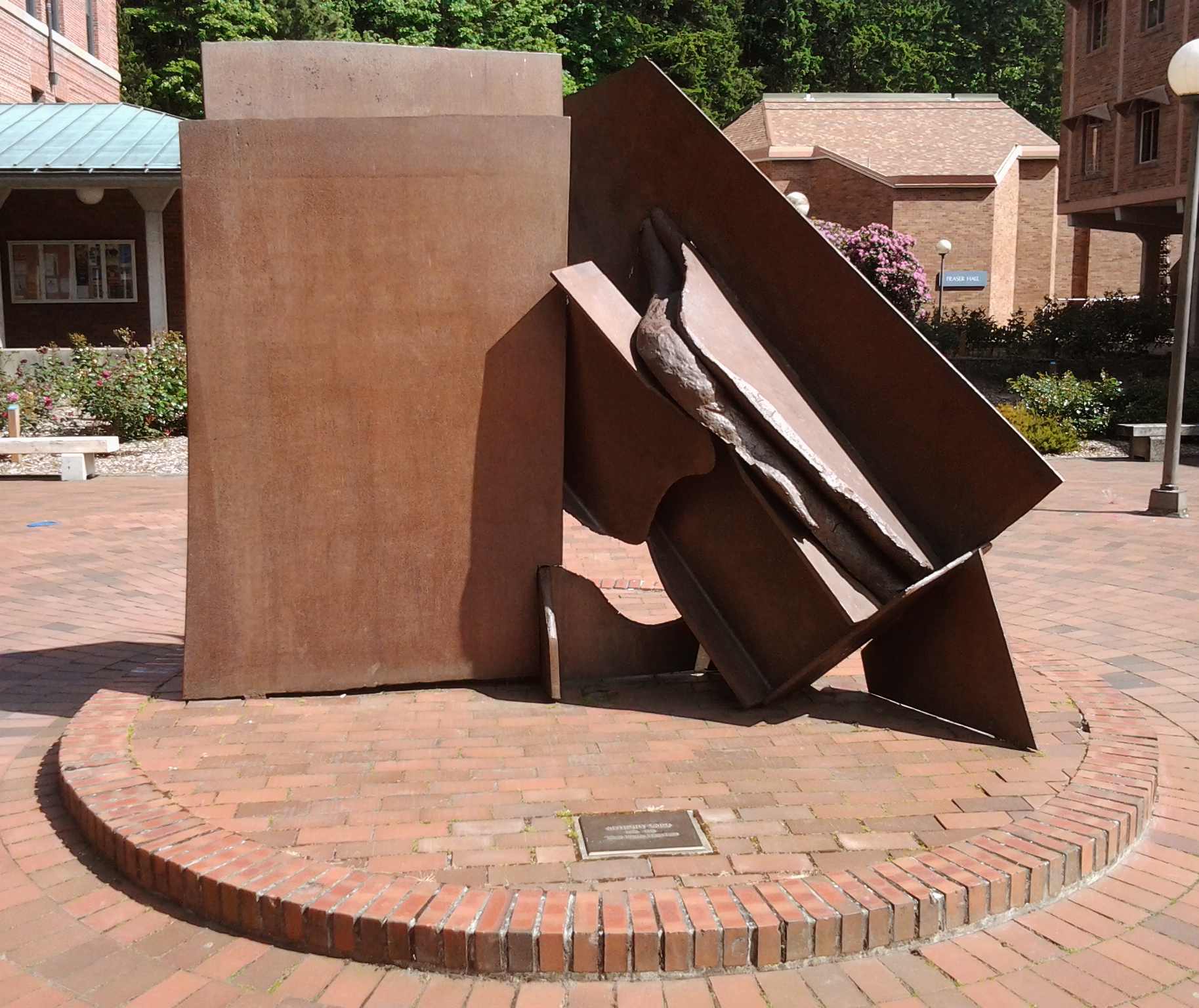
Karissa Reske, Dana Jennings, Serena Southwick
As a group we recreated a smaller rendition of India by Anthony Caro out of project board.
Thousands of students rush around campus every day, racing to their classes and hardly ever stopping to give more than a second glance to the collection of art pieces the grounds of Western Washington University hold. India (1976), a rusted steel sculpture by English abstract sculptor Anthony Caro, is often one of these pieces. Situated between Old Main and the Humanities Building, India stands tall, surrounded by a rose garden and benches for onlookers. To begin learning more about the sculpture one must learn more about its creator: Anthony Caro.
Caro was an abstract sculptor born in 1924 in New Malden, England. While studying engineering at Christ’s College in Cambridge, he spent vacations attending Farnham School of Art and working in the studio of sculptor Charles Wheeler. He also attended Regent Street Polytechnic for a short time where he studied sculpture with Geoffrey Deeley. Caro then studied sculpture at Royal Academy Schools in London and worked as an assistant to Henry Moore, who was an extremely celebrated British sculptor of the post-war period.
At Royal Academy Schools he studied Greek, Etruscan, Romanesque, and Gothic sculptures. While at the school (from 1947-52) he was awarded two silver medals for clay figure modelling and carving and one bronze medal for composition. After his time at the school he began teaching classes at St. Martin’s School of Art In London and had many successful students.
Caro’s works are often composed with large steel sheets (painted or rusted), bronze, or ceramics. He also has paper sculptures, wood sculptures, and even lead and silver. It’s clear through Caro’s hundreds of works he was passionate about his craft. When asked about sculpting in an interview, he responded, “It’s my life. For me, it’s my life.”
In 1971, Caro traveled the world with his family and visited many places, including India, where he was inspired by their architecture. He also went back to India in 1989, 13 years after his sculpture by the same name was created. His sculpture India is one of his rusted and varnished steel works. The larger sheets of steel look as though they are propping each other upright, with smaller pieces of steel of varying textures and cuts finishing off the sculpture.
Around the time of his first travels to India in the early 1970s, activists were attempting to liberalize the economy. There were high tensions between the dictatorship and the desire for democracy. India had been expanding very slowly. The economy and gross domestic product we’re slowing down improvement and the population was growing, leaving little room for improvement of living standards. The percentage of literate women versus literate men in the area was extremely uneven, while poverty and unemployment rates had risen tremendously.
These factors may have played a large part in Caro’s sculpture, which was completed in 1975. The metal standing perpendicular to the ground may represent the people in power at the time. The uneven, jagged pieces leaning up against the tall, upright ones may be the citizens pushing against the higher power. India could easily be representational of the economic hardships during that time. An alternative view is that the metal parallel to the ground is the citizens attempting to stand tall throughout the rough times, and the crooked, jagged pieces of metal represent the crooked, jagged people in power at that time.
Interpretations of Anthony Caro’s work are various, however it would be hard to deny that the purpose behind his work India is not connected to the events in India at the time this sculpture was created. India remains standing tall on Western’s campus, a reminder of another time as its rusted steel blends and fits right in with the red brick around it. Art has its own way of recording history and Anthony Caro’s pieces, especially India, give a look into the past every time you see it, even if it’s just a second glance as you race to class.
SOURCES:
Sir Anthony Caro – Sculptor. N.p., n.d. Web. 24 Apr. 2017.
“Anthony Caro.” Wikipedia. Wikimedia Foundation, n.d. Web. 24 Apr. 2017.
Sculpture Is My Life – Anthony Caro. N.p., 8 July 2011. Web (Video). 24 Apr. 2017.
Williamson | The Rise of the Indian Economy. N.p., n.d. Web. 26 Apr. 2017.
India Liberalization in the Early 1990s – Flags, Maps, Economy, History, Climate, Natural Resources, Current Issues, International Agreements, Population, Social Statistics, Political System. N.p., n.d. Web. 26 Apr. 2017.
Riddy, John, Karen Wilkin, and Ian Barker. Caro. Munich: Prestel, 1992. Print.


October 4, 2024 at 10:22 am
Hello I am so glad I found your weblog, I really found you by mistake, while I was
browsing on Aol for something else, Anyhow I am here now
and would just like to say cheers for a fantastic post and a
all round thrilling blog (I also love the theme/design), I don’t have time
to go through it all at the moment but I have saved it and also added your RSS feeds,
so when I have time I will be back to read a lot more, Please do keep up the fantastic work.